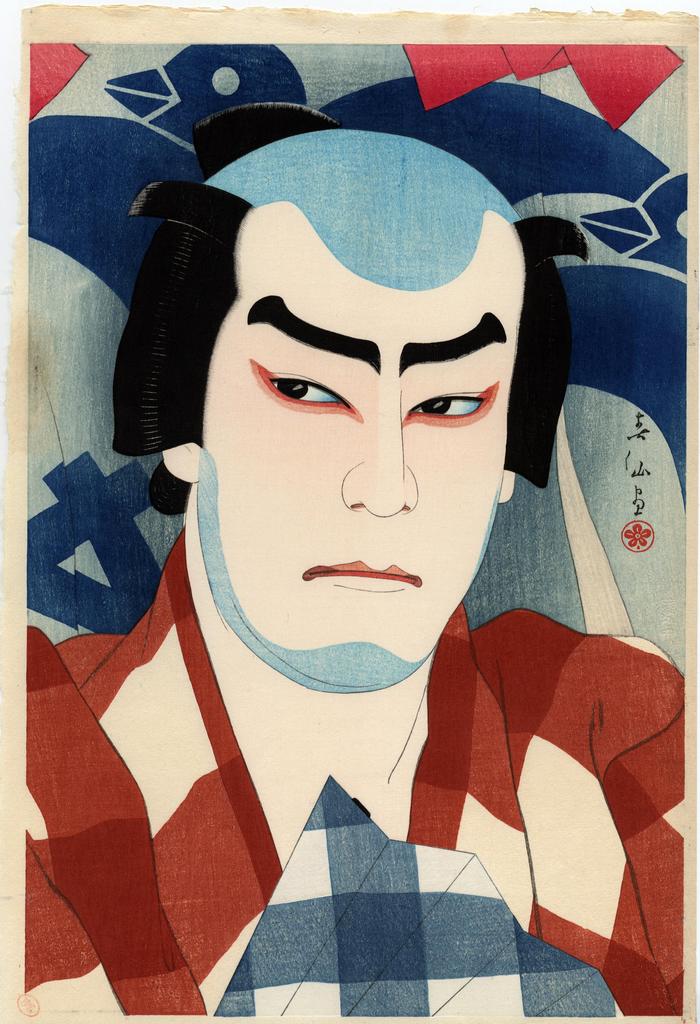Natori Shunsen (名取春仙) (artist 1886 – 1960)
Jitsukawa Enjaku II as Danshichi Kurobei from the series Shunsen nigao-e shū (Collection of Shunsen Portraits)
1926
10.75 in x 15.75 in (Overall dimensions) color woodblock print
Signed: Shunsen ga (春仙画)
Artist's seal: a flower in a circle
Publisher: Watanabe Shōzaburō (seal in lower left)
Waseda University
British Museum
Museum of Fine Arts, Boston
Los Angeles County Museum of Art
Minneapolis Institute of Arts
Honolulu Museum of Art
Achenbach Foundation for Graphic Arts
National Gallery of Australia
National Museum of Asian Art
Art Gallery of South Australia
National Diet Library
Toledo Museum of Art The curatorial files at the Minneapolis Institute of Arts provides this information: "Fourteenth design of a set of 36. Based on Jitsukawa Enjaku II as Danshichi Kurobei in the scene Tsurifune sabu uchi of the play Natsu matsuri naniwa kagami 夏祭浪花鑑 釣船三婦内 (Summer festival: Mirror of Osaka), performed at the Kabuki Theater, August 1925."
****
Natori Shunsen studied traditional Japanese painting at the Tokyo School of Fine Arts and after graduating from the program took an illustrator position at a Tokyo newspaper as he continued to exhibit his paintings in the city’s galleries. The prominent print publisher Watanabe Shōzaburō (1885-1962) saw Shunsen’s paintings and proposed a mutually-beneficial working relationship. Shunsen went on to create several print series over the years with Watanabe, usually in very small, luxury editions that often featured metallic pigments and deep embossing. Shunsen’s prints were marketed by subscription only, making them rare and rather expensive to collect even in the short-term. This series was issued as an actor portrait per month over the years 1925-31.
Shunsen worked primarily within the okubi-e (“large head”, bust portrait) format aiming to capture and convey the individual personality of an actor, as well as the character’s, in a kabuki role. This compelling example of Jitsukawa Enjaku II (二代目實川延若:1877-1951) playing the role of Danshichi Kurōbei (団七九郎兵衛) is widely considered a masterpiece of the genre. Collector Mike Lyon believably claims that it, ”makes my heart beat fast,” every time he sees it. Its basic color scheme is technically very complex, with numbers of blocks needed to print the varying intensities of checked patterns along with the delicately-rendered facial expression. In the nine-act play, Natsu matsuri naniwa kagami [Summer Festival, Mirror of Naniwa] performed in1926, the hero Danshichi Kurōbei is popularly felt to embody aspirations of common folk. Scholarly speculation places the scene of this complicated plot to when Kurōbei is freshly barbered and shedding his prison appearance immed landing in the new role as protector to a runaway courtesan The actor Enjaku II himself was known as graceful and charming, enjoying an extravagant lifestyle as an inveterate ladies man, and this was considered one of his best roles.
****
"Shunsen captures the heroic essence of the handsome Danshichi Kurōbei as he swaggers out of the barbershop in a clean red-and-blue checked kimono. The characteristic curtains of the barbershop can be seen in the background.
Jitsukawa Enjaku II (1877-1951)
A charismatic and well-loved star, Jitsukawa Enjaku II began acting in Osaka in 1886. He first appeared on the Tokyo stage in 1899. Performances in which he co-starred with Nakamura Ganjirō I were particularly popular. Enjaku II was adept at a number of male-role acting styles, and then the hero Danshichi was one of his finest. Offstage he was a notorious womaniser."
Quoted from: Stars of the Tokyo Stage, p. 92.
****
Illustrated
1) in color in 名取春仙, 1991, #25, p. 37.
2) in a full page color reproduction in The Japanese Print Since 1900: Old Dreams and New Visions by Lawrence Smith, p.52.
3) in color in Seven Masters: 20th-Century Japanese Woodblock Prints from The Wells Collection, Minneapolis Institute of Arts, 2015, p. 92.
4) in color in The New Wave: Twentieth-century Japanese prints from the Robert O. Muller Collection, Bamboo Publishing, Ltd. and Hotei Publishing, 1993, page 163, no. 197.
5) in color twice in Stars of the Tokyo Stage by Lucie Folan, et al., National Gallery of Australia, 2012, pages 19 and 93.
****
There is another copy of this print in the Minami-Alps City Shunsen Museum.
actor prints (yakusha-e - 役者絵) (genre)
modern prints (shin hanga - 新版画) (genre)
Jitsukawa Enjaku II (二代目実川延若: October 1915 - February 1951) (actor)
Danshichi Kurobei (団七九郎兵衛) (role)
Watanabe Mokuhan Bujitsu Gahō (渡邊木版美術画舗) (publisher)
ōkubi-e (大首絵) (genre)
